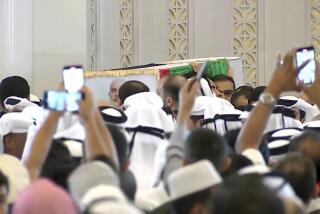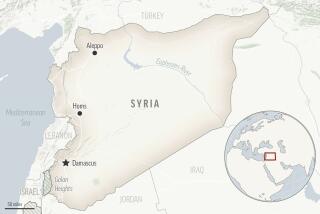Violence flares across Syria amid Assad effort to clamp down
Reporting from Beirut — A renewed wave of violence swept across Syria on Friday as the government of President Bashar Assad sought to counter mass protests and armed insurgents in cities and towns brimming with rebellion against his rule, according to opposition accounts.
More than 120 people have been killed in the last two days, the opposition says, signaling one of the bloodiest stretches of an uprising that began 10 months ago and that now threatens the more than four-decade reign of the Assad family.
The chief of the Arab League’s monitoring team in Syria, Sudanese Lt. Gen. Mohammed Ahmed Dabi, said violence had “escalated dramatically” and could undercut any chance for a negotiated peace in the divided nation.
Persian Gulf nations, including Saudi Arabia, have withdrawn their monitors from Syria, leaving the Arab League’s much-discussed peace plan for Syria on life support.
Gulf monarchies seeking Assad’s ouster are looking to partner with Western allies, including the United States, in crafting a United Nations Security Council resolution condemning the Syrian leader, with the hope of hastening his departure
But Assad’s ally, Russia, which holds veto power on the Security Council, indicated again Friday that it would block any resolution that could lead to sanctions or military intervention against the Syrian state.
Even as the diplomatic front shifted to New York, the situation in Syria remained extremely volatile.
Amateur and news video showed large-scale demonstrations from the suburbs of Damascus, the capital, to the central city of Homs, long a hotbed of the revolt, to the southern region of Dara, near the Jordanian border. Protests were also reported in the northwest, near the Turkish border. Rebels wielding AK-47 assault rifles accompanied many of the protesters.
The opposition alleged that the government had unleashed a barrage of heavy weaponry on Homs, killing dozens.
Still, amateur video showed demonstrators taking to the streets of Homs, chanting “Bashar Assad is the terrorist!” — a rejection of the government’s contention that the armed opposition is composed of terrorists.
In the southern town of Nawa, government forces killed 11 civilians, including three women and a child, when security gunmen opened fire on the funeral of a high school student slain the previous day by government forces, according to the Local Coordination Committees, a coalition of opposition activists.
Opposition accounts of deaths could not be independently verified.
By most accounts, Assad’s army remains strong and has the ability to storm opposition strongholds in force, as troops were reported to have done in recent days in the cities of Homs and Hama. Assad also still has considerable support, especially among Christians and other minorities who fear the prospect of an intolerant Islamist leadership in Syria.
The official Syrian Arab News Agency reported Friday that 10 citizens were injured when “an armed terrorist group” fired mortar rounds at Homs’ Nuzha district, targeting a traffic circle. “Terrorists” also shot and killed a mother and her 14-year-old son in Homs’ Tarik Sham neighborhood, the government news agency reported, while five bodies “mutilated by terrorist groups” were found in another section of Homs.
This week’s offensive in Homs may signal the regime’s desire to reassert itself in the rebellious town and avoid the creation of a de facto liberated rebel capital.
The images and reports of violence by both sides have left no doubt that an opposition movement once mostly characterized by large-scale peaceful protests now has substantial weaponry and armed manpower.
Protests were reported in several Damascus suburbs, including Duma and Saqba, where, according to news images, armed insurgents roamed freely and set up defensive positions.
A resident of Duma, an opposition stronghold, said by telephone that about 500 rebels of the so-called Free Syrian Army were protecting protesters during the day. Still, he said, the suburb was not under full rebel control and military snipers had killed at least three people.
Meanwhile, Iranian state media reported Friday that “terrorists” in Syria had kidnapped 11 Iranian pilgrims traveling by road from Turkey to Damascus. The gunmen stopped a bus with 49 Iranians and abducted 11 young men from the vehicle, but let the others go. Last month, seven Iranian engineers building a power plant in Syria were kidnapped. The fate of the abducted Iranians remained unclear.
And in Egypt, vandals stormed the Syrian Embassy in Cairo, prompting Syrian authorities to condemn Egypt for failing to protect the diplomatic mission.
Marrouch is a special correspondent.
More to Read
Sign up for Essential California
The most important California stories and recommendations in your inbox every morning.
You may occasionally receive promotional content from the Los Angeles Times.










